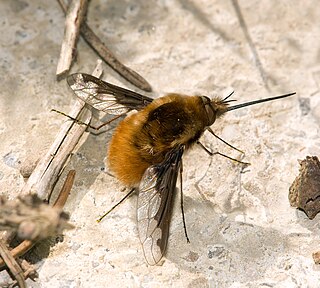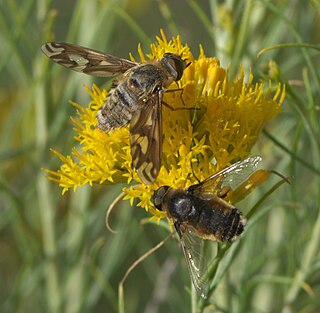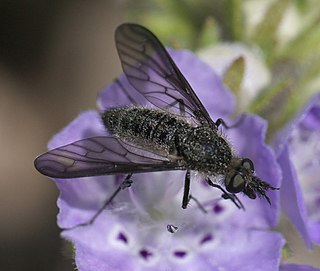
The Bombyliidae are a family of flies, commonly known as bee flies. Some are colloquially known as bomber flies. Adults generally feed on nectar and pollen, some being important pollinators. Larvae are mostly parasitoids of other insects.

Poecilanthrax willistonii, Williston's bee fly or sand dune bee fly, is a member of the Bombyliidae insect family. This family includes the bee flies, true flies that have developed Batesian mimicry characteristics to avoid predators. That is, they look like bees because that helps them avoid bee-wary predators, but they lack stingers.
Exoprosopa parda is a species of bee fly in the family Bombyliidae.
Ogcodocera analis is a species of bee fly in the family Bombyliidae. It is found in Mexico, Arizona, and Texas.
Ogcodocera is a North American genus of bee flies in the family Bombyliidae. There are two described species in the genus Ogcodocera.

Geron is a genus of bee flies in the family Bombyliidae. There are at least 180 described species in the genus Geron, found on every continent except Antarctica.
Systropus angulatus is a species of bee fly in the family Bombyliidae. It is found in Texas.
Poecilanthrax nigripennis is a species of bee fly in the family Bombyliidae.
Bombylius atriceps is a species of bee flies in the family Bombyliidae.

Aldrichia ehrmanii is a species of bee fly in the family Bombyliidae. It is found in the northeastern United States and Ontario, Canada.
Paravilla aridula is a species of bee fly in the family Bombyliidae. It is found in Arizona and California.
Paradiplocampta is a genus of bee flies in the family Bombyliidae. There is one described species in the genus Paradiplocampta, P. tabeti, known from California and Arizona.

Exoprosopa jonesi is a species of bee fly in the family Bombyliidae.
Paravilla californica is a species of bee fly in the family Bombyliidae. It is found in the southwestern United States and northwestern Mexico.
Hemipenthes inops is a species of bee fly in the family Bombyliidae. It is found in the western United States. It is somewhat unusual compared to other members of the genus Hemipenthes in that its wings are mostly transparent.
Paravilla cinerea is a species of bee fly in the family Bombyliidae. It is found in Arizona and Baja California Norte.
Bombylius curtirhynchus is a species of bee flies in the family Bombyliidae.
Exoprosopa eremita is a species of bee fly in the family Bombyliidae. It occurs in western North America.

Lomatiinae is a subfamily of bee flies in the family Bombyliidae. There are about 16 genera and at least 290 described species in Lomatiinae.

Anthrax analis, the black bee fly, is a species of bee fly in the family Bombyliidae. It can be found throughout North America, from the Yukon east to Quebec in Canada, the entire mainland United States, most of Mexico, and as far south as Costa Rica and Cuba. As an adult it is a pollinator, and as a larva it is a parasitoid of tiger beetles in the genus Cicindela, and likely also of solitary bees. It is variable in appearance, with the posterior half of the wings usually transparent, but in the eastern United States the wings may be entirely dark.. The body itself is covered in black hair, but the tip of the abdomen usually has silvery scales.






